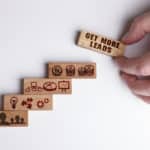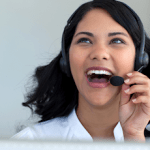In this post I break down the best way to create a scalable B2B lead generation process using LinkedIn. Then I’m going to give you a couple of specific case studies on what can be achieved.
This is the exact same process we used to generate ongoing streams of leads for a client, a mature B2B SaaS vendor in a highly competitive niche, for just $16.76 per lead.
This step by step guide that will tell you exactly where to focus your attention for maximum impact.
- Why LinkedIn is the Best Platform for B2B Lead Generation
- How to generate B2B leads on LinkedIn
- How to Run a Profitable LinkedIn Lead Generation Campaign
- 0. Before you Do Anything Else, Optimise Your LinkedIn Profile for B2B Lead Generation and Become a Valuable Member of the Community
- 1. Target Top of the Funnel prospects
- 2. Use a Relevant Piece of Persona and Journey Based Content
- 3. Use The "Lead Generation" Campaign Objective
- 4. Use a Simple, Image-Based Post
- 5. Include Only these Form Fields
- 6. Automatically load conversions to your CRM
- 7. Follow up: Start the Sales Process Immediately
- 8. Leverage LinkedIn Analytics for Insightful Data
- LinkedIn B2B Lead Generation Case Studies
Why LinkedIn is the Best Platform for B2B Lead Generation
LinkedIn is the premier platform for B2B marketers seeking to generate high-quality leads. With over 900 million members worldwide, including 65 million decision-makers, LinkedIn offers unmatched access to a professional audience.
Consider that:
- The LinkedIn user group is large – 11 million Australian employees.
- 50% of B2B web traffic originating from social media comes from LinkedIn.
- B2B marketers report that 80% of their social media leads come from LinkedIn.
- HubSpot reports LinkedIn is 277% More Effective for Lead Generation Than Facebook & Twitter
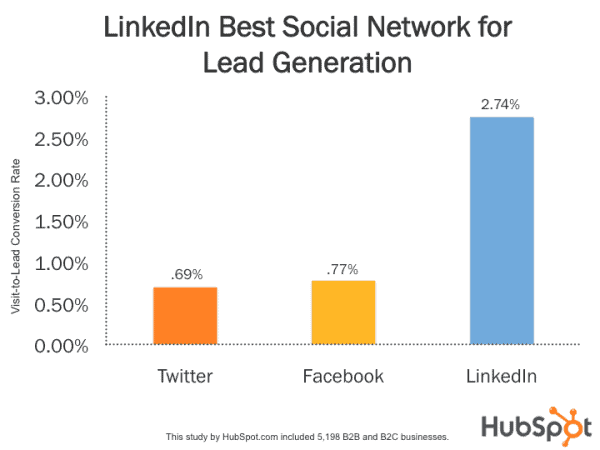
The effectiveness of LinkedIn for B2B lead generation can be attributed to several key factors:
- Targeted Audience: LinkedIn’s targeting options allow you to reach customers based on job title, company size, industry, location, and other crucial factors, ensuring your content and ads reach the right people.
- Professional Mindset: LinkedIn users are in a professional mindset, actively seeking valuable content, insights, and solutions to improve their businesses. They are more receptive to engaging with brands that can help them achieve their goals.
- Thought Leadership: By consistently sharing valuable content and engaging with your audience, LinkedIn provides a platform to showcase your expertise and establish your company as a thought leader in your industry, building trust and credibility with potential leads.
- Diverse Lead Generation Tools: LinkedIn offers an array of lead generation solutions, including Sponsored Content, Message Ads, Lead Gen Forms, and Sales Navigator, enabling you to effectively reach and engage your target audience.
By leveraging LinkedIn’s suite of lead generation options, businesses can not only capture high-quality leads but also streamline the entire lead nurturing process, from targeting to conversion.
How to generate B2B leads on LinkedIn
There are three main ways to generate B2B leads on LinkedIn:
- Social selling: posting on the platform and growing your organic audience and connecting with them;
- Direct messaging: sending prospects either Connection Requests or InMail emails
- Advertising: paid promotion of content – LinkedIn even has a specific type of advertising targeting Lead Generation. It’s called, drum roll please, “Lead Generation”!
How to Run a Profitable LinkedIn Lead Generation Campaign
While Social Selling and Direct Messaging can be great, they are also difficult to scale effectively.
In this post we’ll focus instead on the use of Advertising to generate sales leads.
Further we’ll focus on a content marketing led strategy where you exchange valuable business content for a prospects contact details and permission to contact them.
Here are the seven keys to maximising your advertising lead gen results on LI.
0. Before you Do Anything Else, Optimise Your LinkedIn Profile for B2B Lead Generation and Become a Valuable Member of the Community
An optimized LinkedIn profile can greatly enhance your lead generation efforts by ensuring that when leads check your Personal and Company profile it captures their interest.
Optimize your headline
Your headline is one of the first things people see when they view your profile. Make sure it is clear, concise, and highlights your expertise. Use relevant keywords that your target audience might search for to increase your profile’s visibility.
Use a professional profile photo
A high-quality, professional photo can help establish trust and credibility. Ensure that your photo is recent, clear, and represents you in a professional manner.
Craft a compelling summary
Your summary is an opportunity to showcase your expertise and explain how you can help potential clients. Focus on the value you bring, your achievements, and the solutions you provide. Don’t forget to include relevant keywords to improve your profile’s searchability.
Showcase your experience
Detail your professional experience and accomplishments, emphasizing your expertise in your industry. Make sure to highlight your most relevant experiences and the results you’ve achieved for your clients.
Feature rich media and recommendations
Add rich media such as videos, presentations, or articles to showcase your work and demonstrate your expertise. Additionally, ask for recommendations from clients or colleagues who can speak to your skills and the results you’ve delivered.
Optimize your company page
Your company’s LinkedIn page is an essential component of your B2B lead generation efforts. Ensure that your page has a clear and informative description, includes relevant keywords, and showcases your products or services.
Become Known and Valuable
Creating and sharing high-quality content helps you become a known and valuable member of the LinkedIn community – which is essential for successful LinkedIn B2B lead generation.
Regularly posting valuable, industry-relevant content positions you as a thought leader and keeps your brand top-of-mind for potential leads. Aim to share content at least 2-3 times per week, focusing on topics that address your target audience’s pain points and interests.
Experiment with a mix of content types because, while text posts can be effective, incorporating visuals such as infographics, charts, and videos significantly boost your content’s appeal.
According to LinkedIn, posts with images receive 98% more comments than those without. Video content is particularly powerful, with LinkedIn users 20 times more likely to share a video post than any other type of content.
Engage and Network with your Prospects and Other Thought Leaders
But lead generation on LinkedIn goes beyond simply posting content; it requires active engagement and relationship building.
Make it a habit to spend at least 15-20 minutes daily interacting with your network. Like, comment on, and share posts from your connections, especially those from potential leads or industry influencers. Thoughtful comments that add value to the conversation can help you stand out and build meaningful relationships.
Don’t automate this process – to be effective it needs to be human to human.
Joining and participating in relevant LinkedIn groups use to be a good strategy but in the last 5 years I’ve seen these groups become wastelands for spam and simple promotional posts so it’s not something I currently recommend
1. Target Top of the Funnel prospects
While it is possible to convert people directly with Bottom of the Funnel offers (free trial, book an appointment, etc) you need a strong brand to do that: HubSpot, Salesforce, etc.
For everyone else, it’s an expensive and low yield approach.
Instead, go for Top of the Funnel conversions. Prospects are much more likely to download a useful resource and once they’re in your database you can nurture them long term.
2. Use a Relevant Piece of Persona and Journey Based Content
Your content must be of high quality and relevant at both a Persona and Journey level.
Content targeted to the right persona and journey step generates leads that are of high sales value.
Un-targeted “click-bait’ content might convert highly but generates low value leads.
Low quality content (thin, poor visually, typos, etc) also reflects poorly on your brand.
3. Use The “Lead Generation” Campaign Objective
There are seven different LinkedIn Advertising Campaign Objectives:
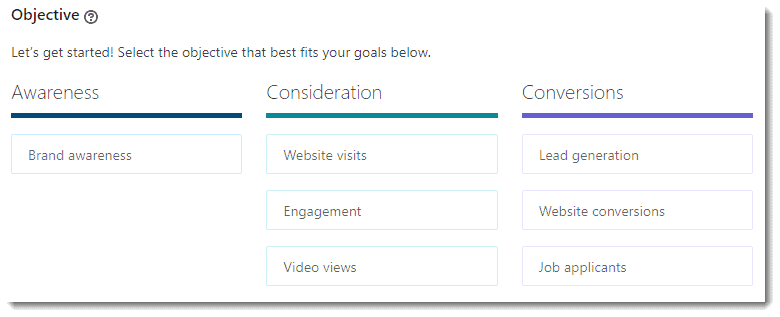
Of these Lead Generation and Website Conversions can be used for lead generation purposes but you should use Lead Generation.
Website Conversions pushes the person directly to your website landing page for conversion there.
However, Lead Generation puts the conversion form right in the promoted content. It also pre-fills the form fields from the user’s LI profile. Fewer, easier, steps to conversion.
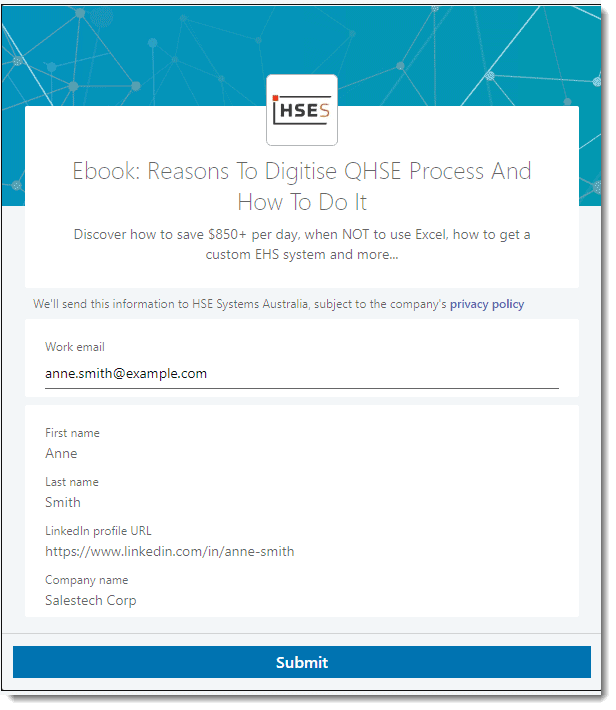
If you use Website Conversions and push them to your website it has two major negative impacts:
- More clicks: they must click on more links to get to your site and the download. Every click lowers conversion
- Harder Data Entry : they must manually fill out the fields on your form. This dramatically increases effort, and the potential for misentry due to typos
Both of these are significant impediments for users browsing on mobile devices and LinkedIn says 57% of traffic is on mobile devices so this is important.
When they can just hit the “download” button without even leaving the LinkedIn app, conversion is higher.
Our side-by-side testing confirms that Lead Gen forms have a higher conversion rate than Website conversion forms
4. Use a Simple, Image-Based Post
Essentially, LI Lead Generation adverts are just posts that are promoted in the LinkedIn feed.
When designing your ad remember that you only have a second or two to catch their attention and get them to act, so be direct.
Of course you need test different text and images for your advert to determine what works best for you, but here are some starting points:
- Simple and direct “Introductory Text”: in this case targeting a job type
- Make your download “physical” – no artistic interpretation here. Show them what they are getting, even though it’s digital, and give them an immediate benefit.
- Show them how to get it: “Download” works pretty well
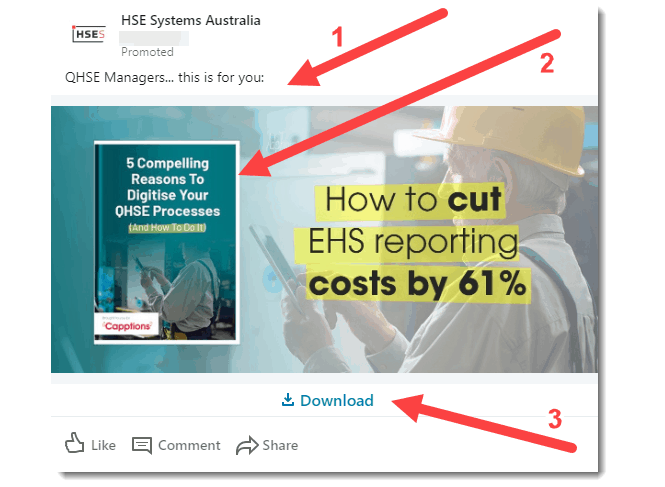
5. Include Only these Form Fields
Your form can contain as many fields as you like but, as for all conversion forms, the fewer fields, the higher the conversion rate.
Note: all of the fields are mandatory so you’ll get data for anything you request.
Here is what you should ask for:
First Name and Last Name
Name split into first and last name so they feed into your CRM properly.
Many people use a personal email address for their LinkedIn profile so if you ask for email you’ll likely get a personal email.
You can also ask for business email but you’ll still mostly get their personal email again. In our testing 71% of the time you end up with a personal address even if you ask for a company address.
In many respects this doesn’t matter because there there are plenty of ways to find someone’s email address from their name and company domain.
Tip: With the right software you can even export email lists from LinkedIn
LinkedIn Profile URL
This is the real gold – ask for their LI profile URL.
With this you don’t need to ask for their company, title, industry, etc, etc, it will all be in their profile.
Now, normally you need Company, title, etc to qualify leads but remember you’ve carefully set the audience for this advert so you already know they are broadly qualified.
Yes it takes a few seconds to update the details in the CRM but you were already going to check out their profile before contacting them, so nothing lost and more conversions gained.
That’s probably all you need.
6. Automatically load conversions to your CRM
Depending on your CRM, form fills can be automatically imported and actioned. HubSpot for instance has this ability.
Even if your CRM doesn’t have this ability natively, use Zapier to make it happen. You can download the leads from LinkedIn manually and upload them to your CRM but that takes time and, more importantly, delays the follow up process. Make it automatic.
Now, you can automatically follow up with prospects and notify your sales team.
Tools such as ContactOut can help you automate your outreach and follow-up process on LinkedIn.
7. Follow up: Start the Sales Process Immediately
Excellent – they’ve downloaded your super cool piece of content. You can sit back and relax. They’ll call with the order!
Yeah, not so much.
You can make a couple of assumptions about that excellent piece of content they downloaded:
- They probably don’t know where the download got saved and even if they do:
- They have not read it.
So you need to follow up, and quickly. Within an hour, or even better 10 minutes you need to:
- Send them a company branded email with the download included.
- Send them a note from a business development rep / account manager “reaching out” to assist.
- Start your formal lead nurture process
8. Leverage LinkedIn Analytics for Insightful Data
LinkedIn is a robust source of valuable data that can significantly enhance your lead generation strategy. When you pay close attention to LinkedIn Analytics, you can unlock a treasure trove of insights about your audience and your campaign performance.
LinkedIn Analytics offers a detailed breakdown of your audience demographics – including job function, location, seniority, and industry. This information helps you to understand if you’re reaching your desired audience or if you need to adjust your targeting parameters.
The LinkedIn Campaign Manager provides detailed metrics about your advertising campaigns. Ensure that you are constantly monitoring your campaign’s performance, looking at key metrics like click-through rates, conversion rates, and cost per lead. You can see which ads are performing well and which ones may need tweaking.
In addition, engagement metrics – likes, shares, comments, and follows – are a clear indication of how your content resonates with your audience. If a particular post garners a lot of engagement, that a size that your audience finds that type of content valuable. Use this insight to shape future content and campaigns.
LinkedIn B2B Lead Generation Case Studies
Case Study 1: Mature Australia SaaS Vendor (Includes Results)
Here are the results we achieved for a mature SaaS vendor to give you an idea of what is possible.
Company Background
- Mature Australian SaaS vendor
- Highly competitive market space
- Tightly defined buyer persona and company firmographics
- LinkedIn form integration with client CRM driving automated follow up campaign and sales team engagement.
- Website with rich content at each stage of the buyer’s journey (top of the funnel to bottom of the funnel) with steadily growing website traffic and high value downloadable assets.
Campaign Goal
- While the website generates a steady rate of prospects there was a desire to supplement lead volumes to the sales team with targeted prospects in key industries.
Campaign Details
- Advertising targeted at
- Australian companies and government agencies
- Specific industries
- Corporate and Enterprise sized organisations
- Specific job titles
- Strong Introductory copy and “physical” asset based image
- Strong and relevant download asset
Results
- Cost Per Lead: A$16.76
- Post Engagement Rate: 2.77%, anything above 2% is considered very good
- Campaign duration: ongoing, with regular updating of creative and assets to maintain cost per lead
- Click through rate: 0.99% (going to client main site)
Case Study 2: SaaS Vendor – Entry to Australia (Includes Results)
We achieved these results for a new SaaS entrant to the Australian market.
Company Background
- International SaaS vendor entering Australian marketplace
- Tightly defined buyer persona and target company firmographics
- LinedIn form integration with client CRM driving automated follow up campaign and sales team engagement.
- Website has thin local, i.e. Australian, content and little traffic but included a couple of valuable assets.
Campaign Goals
- Generate immediate prospects for the Australian sales force while building out the long term content marketing process.
Campaign Details
- Advertising targeted at
- Larger SME companies
- Specific job roles
- Strong Introductory copy and “physical” asset based image
- Persona and journey relevant content asset
Results
- Cost Per Lead: A$15.72
- Post Engagement Rate: 1.9%, anything above 2% is considered very good
- Campaign duration: 4 week fixed with same creative and assets
- Click through rate: 0.80% (going to client main site)



